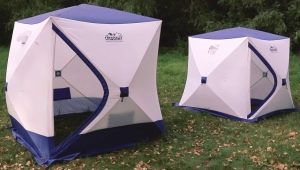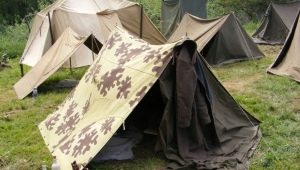Arcs for a tent: varieties and tips for choosing

In order for the tent to retain its functionality for a long time, it must have a reliable, durable frame. Therefore, the choice of design is always associated with the quality of the material from which the arcs are made. Understanding which is better is also important if the part is broken and needs to be repaired.

Requirements for a tent frame
The main characteristics required for the construction of a tent are lightness, flexibility, and the ability to withstand heavy loads. If the structure will be used in winter, for example, for fishing, the material must be resistant to sub-zero temperatures. Additional selection options:
- feature of the connections of parts;
- the possibility of long-term use;
- product price.



However, meeting all these requirements can be difficult. The most durable, hard material can give extra weight, and too flexible can not provide the necessary tensile strength and protection from external influences. Conventionally, the arcs are divided into metal and those made of composites, but in fact the list of types of compositions is quite wide.
Types of metal racks
Arcs for a tent can be made of metal, but there are some nuances here.Lightweight titanium parts have maximum strength and flexibility, however, this is an extremely expensive material, which is why it is not used for the frame. If we take steel racks, then despite their strength, they are heavy and do not differ in plasticity.

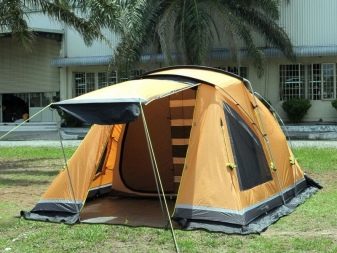
They are used, but for tents that are not intended to be moved.
For modern mobile structures, aluminum alloy arcs are considered the most suitable - such a frame is resilient, durable, and can be repaired. The material is durable, and even after 5-7 years of operation, the pipes remain straight and flexible. Particularly preferred is an aluminum-magnesium alloy, which has many useful properties:
- aluminum sticks withstand negative temperatures;
- they are not subject to deformation;
- the alloy is resistant to ultraviolet rays;
- has a small weight.


Demanded markings are 7001-T6 (DAC arcs) and 7075-T9 (from Easton). At the moment, the TH72M aluminum alloy used in the arcs of the PL, NSL, FeatherLite series of the Korean company DAC is considered to be a universal, strong and durable material with low weight.
Arcs made of multi-component materials
Composite materials for the manufacture of tent racks include the following.
- Fiberglass - a combination of polymer and fiberglass, has the durability and strength of the metal, at the same time is not subject to decay, brittleness. Its hardness and safety margin is 3-4 times higher than that of aluminum alloy, and 8-9 times higher than that of polyvinyl chloride. Damage and deformation are excluded due to thermal contraction and expansion of the glass.Also, fiberglass racks are resistant to alkalis and acids, corrosion, high humidity, have dielectric and thermal insulation properties, and weigh little.

- carbon arches are made of carbon fiber, and they are based on a fiber formed from the thinnest carbon filaments no more than 0.11 mm in diameter. Since the formed web is created by overlap weaving and glued with epoxy resins, the material has a high rigidity. At the same time, such components have a low weight.

- An innovative type of composite composition - S-Glass multidirectional fiberglass used in aerospace engineering. Such arcs are able to maintain their strength characteristics even at wind speeds of 120-130 km/h.

When comparing fiberglass with aluminum and its alloys:
- he loses in weight by about one and a half times;
- has a shorter service life - 2-5 years;
- in case of damage, for example, breakage, the racks will have to be replaced with new ones.

If we take for comparison aluminum, fiberglass accessories and S-Glass fiberglass, then the arcs made from the latter composition have greater elasticity, which is a great advantage in winter conditions. However, fiberglass materials are still the most popular, budget option, and if we are not talking about extreme living conditions, they are quite suitable as a portable tent frame.

Replacing collapsible bends of the arc
The posts and their knees tend to break if you put the tent on an uneven surface, fold it at random or fall (jump) onto the structure. In all these cases, there is a high probability that one or more collapsible parts can be broken.Of course, there is an option to replace these segments with new ones made of fiberglass or other material, but you can optimize the racks yourself.

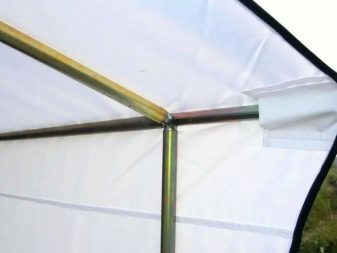
In the event of a breakdown of the tent components, if these are tubular arches with rubber, some craftsmen manage to repair by adding fiberglass parts from reinforcement. To do this, you need to remove the size of the old supports and prepare the appropriate pieces. Tips are preliminarily removed from damaged parts, which are fixed on spare parts by cold welding.

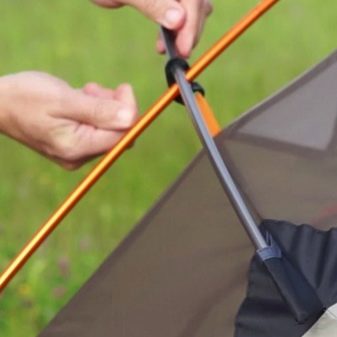
Of course, a folding kit is preferable, since the tent takes up less space in the trunk, however, as an alternative, this is an acceptable solution. And for the future, when choosing a frame material, you need to build on the expected number of field trips and weather conditions in which the tent is supposed to be used. This will be the determining factor which arcs to give preference to.

How to change the arcs for the tent, see the following video.






















